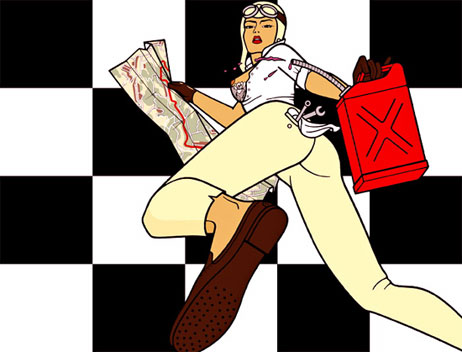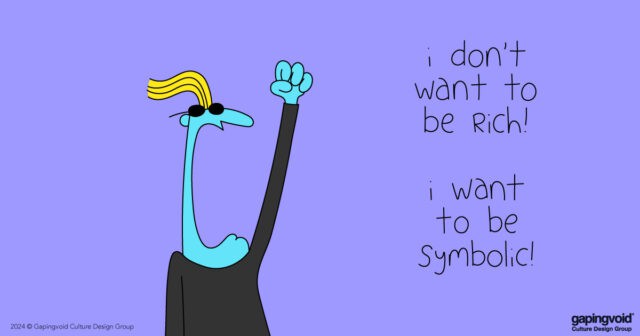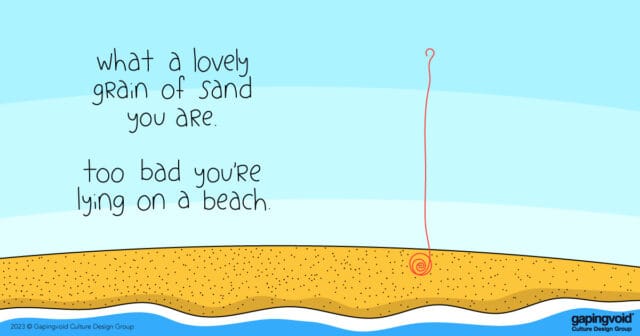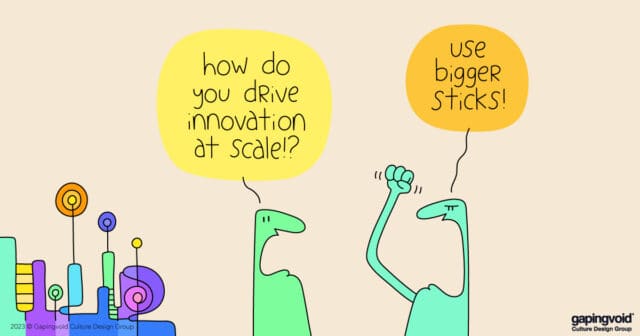
[Hazel Dooney. Study For Dangerous Career Babe: The Race Car Driver (Homage To Hellé Nice). 2009 Acrylic on paper, 40cm x 52cm.]
Hazel Dooney is a young and VERY successful Australian Artist. From the blurb on her website:
In December, 2007, Hazel Dooney was the only female artist under 30 with works included in the prestigious auction, Modern and Contemporary Australian Art, held at Christie’s in London. In what was a record-setting sale, with major works by Brett Whitely, Arthur Streeton, Frederick McCubbin, Sydney Nolan, Arthur Boyd, Fred Williams and Tracey Moffat, two modest early works by Dooney fetched over $AU23,000 each.
You get the idea. We follow each other on Twitter, we exchange the occasional email. I’m a big fan. There are A LOT of artists online, but very few as smart, interesting, talented, successful or as driven as Hazel, so I thought a “Ten Questions” session would be in order. She kindly agreed to answer.
TEN QUESTIONS FOR HAZEL DOONEY
1. I’ve described your work to the non-initiated before as “Hard-Edge, Erotic Pop meets Tank Girl”. That’s a MASSIVE oversimplification, of course. For the benefit of gapingvoid readers, could you tell us more about your work?
I love your description of it – I think I’ll use it in the future. It certainly describes the attitude that suffuses it. In Japan, artists like Takashi Murakami have been labelled Shock Pop and some critics have included me in that. At its core, my art’s about the way contemporary women’s identities and sexuality are defined by advertising, entertainment, even commercial pornography. I’m no different – which is why versions of me turn up in nearly all my work. Moreover, I try to replicate the physical experience of modern advertising and entertainment media which is why my large enamel paintings are produced in series (just like TV shows and ad campaigns).
In some ways, I want to make it harder to tell art (or artist) from product. My works are, fundamentally, conceptual – even if most, so far, have been paintings. But this’ll change over the next few years as I experiment with other media.
2. You found success at a very early age. Was it skill? Luck? Talent? Bad Craziness? How did it all come about?
Desperation, probably. I had a fairly lonely, introspective childhood and an often crazy, drug- and boy-dependent youth so when I finally recognised that I had a modicum of talent, I seized upon it. And I was determined not to waste an ounce of it. I worked bloody hard to put together a solid body of work – mostly large and in enamel (I was nothing if not ambitious). And when I felt ready to show it, I refused to let anything or anybody get in my way. I paid for and promoted my first shows myself and I learnt very quickly how to respond professionally to collectors and the press. I realised that art was the key not to having some kind of success – although I wanted success very much – but to survival. That drove me hard for ten years.
3. The reason you got my attention initially, was hearing about your decision to bag the traditional gallery route, instead electing to sell your work to collectors via online. Tell us a little bit about your business model. Tell us why you decided to circumvent the gallery system. Tell us about what’s working. Tell us about the hard parts. Tell us your thoughts on how social media plays a part in this.
Four years ago, I decided to quit the two highly regarded galleries in Sydney and Melbourne that were then representing my work. We had a dispute over how they wanted to position me and (believe it or not) constrain my prices. I found some very smart people in technology and business who were prepared to help me figure out a way to manage myself – not just marketing and selling my work but creating an infrastructure to manage every aspect of the business of it, from identifying and communicating with individual collectors and producing my own shows to expanding my online presence and exploiting tools such as social networks and email to develop a wider interest in my work and me. Since then, the value of my work has increased to five, maybe ten, times what it was five years ago, and 15 times what it was a decade ago and my career has radically expanded – as has my collector base.
Traditional galleries and art institutions – and the art publications that depend on both for their advertising – have had fuck-all to do with it. Neither did a traditional, ‘high minded’ artist approach. I regarded myself early on as a post-punk performer, a ‘garage band’ version of a modern artist who ends up owning her own label and promoting her own tours. I don’t deal through intermediaries and I try to maintain a direct connection with everyone who has an interest in my work. Which is maybe why my work has done so well at auction recently.
4. You’ve been called “One of the Pacific Rim’s most controversial artists”. That may be true, but I don’t find your work offensive in the slightest- I find it delightful. Sure, Sexuality- Female Sexuality in particular- features heavily in the work, but what’s controversial about that? Everyone’s got a libido, after all. It seems to me that to from your perspective, Sexuality and the Social Conventions that surround it are two things that are there to be played with, like a toy. Like you’re trying to make a serious statement by having fun with it. Am I close?
I think the controversial part reflects my outspoken attitude towards the gallery system – and my rejection of it. I don’t see my work as erotic, really. It just reflects an aspect of how young women in the developed world see themselves. For better or worse, sexuality is always a powerful element of this. Besides, there’s always been both sexuality and sensuality in art. It’s as visible in the works of Michaelangelo as it is in those of Picasso or Modigliani. However, these days, we don’t have the same social, religious or gender constraints. We’re able to delve more deeply and frankly, creating art that is more explicit, darker and in my case, confessional and/or critical.
That said, yeah, I do like to have fun with it. My Dangerous Career Babes series is a case in point. A lot of women like to dress up to pretend roles as adults. This is different to actually being something. It’s a form of play-acting. So in this series, each figure has exactly the same pose, like an action figure or a Barbie doll, with one hand designed so props can be slid into it, the other formed for gestures or actions. Just as in real life, the costumes are the key. The figure is a dress-up doll. The career that the figure assumes in each painting is identifiable because of the clothes.
Needless to say, the glibness of this concept pisses some critics off. Me, I think it’s a hoot.
5. As a well-known and charismatic artist, suddenly you find yourself with a “Public Persona”. This “Meta-Hazel”, as it were, running around, going to all the right parties etc. You seem quite happy with your relationship with MetaHazel. Was this always the case, or did it grow on you?
In many ways, it was part of my early survival mechanism. I was immersed within her the moment I recognised my future as an artist. Now we’re so thoroughly interconnected, there’s no other Hazel but the Meta-Hazel, as you put it.
Actually, she’s still quite reclusive and rarely goes to a lot of parties. She’s way too busy. But she has a damn fine lifestyle and her sex life is… arcane, involving a very cool, hugely talented man and a bevy of young Asian camp-followers.
6. Everybody has a “Fantasy Version of Themselves”. You know, that fantasy person who manages to get all their work done, while still having enough room left over to do everything else- like getting a life, for example. What does “Fantasy Hazel” do with herself these days?
‘Fraid not, in my case. See above. I live every aspect of my dreams to the hilt, even if most of them are still driven by a need to make art and succeed (within a wide frame of definitions) as an artist.
7. No matter how big your “Personal Brand” becomes, at the end of the day, you still have to do the work. As I’m fond of saying, “Success is more complex than Failure.” As your work gets more and more known, beyond Australia and Asia, are you having any trouble keeping up? How do you negotiate the ever-increasing demands placed on you, by your fans, collectors, the media and business interests? This increased complexity is something I always struggle with, so yeah, please do tell.
Some days, the work is tedious, labour-intensive and as repetitive as a production line in a factory. This is particularly the case when I am working with assistants on a handful of large pieces at the same time – and yes, it would be impossible to work on the very large enamels without them, as I’ve become increasing allergic to the medium. On other days, it can be almost languid. I draw or paint alone, in a room overlooking the ocean, and an assistant looks after phone calls, prepares snacks for me, and ensures I’m left in peace.
The most frenetic times are just before my exhibitions – ‘show time’ as my assistants call it. My openings are usually pretty extravagant so the logistics are complicated and usually bloody expensive, mainly because I produce my own shows these days.
The key is having a good infrastructure. Apart from my assistants, I have an excellent business manager and accountant who ensure that the right financial and logistical decisions are made for me. I always listen closely to them and follow their advice. And I have the wonderful Jim, a wise, older man who oversees the work-flow on my commissions and the mundane details of production, like ensuring we have enough frames built or the right colour paints to hand.
But none of it works without discipline. Early on in my career, I was told that success demanded one thing above all others: turning up. Turning up every bloody day, regardless of everything.
8. I’ve noticed a lot of well-known artists, like yourself, like Damien Hirst, are now selling their work via auction houses like Christie’s or Sotheby’s, rather than Blue-Chip galleries. What do you think brought this about? Pros? Cons?
It’s cleaner and a lot less effort than dealing with commercial galleries. Despite what they pretend, very few galleries or gallerists have what is required to develop and manage even a moderately successful career, let alone a stellar one – nor do they even want to. So I manage my own career and encourage my collectors to use auction houses for acquisitions and sales. I don’t yet sell on my own account through them but after Hirst and Sotheby’s… maybe.
I have great relationships with the best of them in Australia and collaborate in their marketing efforts for my works ahead of a major sale. They’re polite, helpful, good to deal with. I haven’t met an art dealer about whom I can say the same. Not yet anyway.
9. You have strong opinions about the art world, especially the big art institutions. What are your pet peeves? What do you think needs to change? What would you change if you could?
Oh, I’d tear down nearly everything and replace it. Or not replace it at all. The dark creed underpinning my attacks on the traditional commercial and institutional gallery system is that the system deliberately attempts to determine, control and sometimes destroy the destiny of individual artists – promoting some at the expense of others, making arbitrary judgements influenced by fad, self-interest, even government funding – for its own interests, none of which are to do with art.
Nowadays, too many galleries, public and private, see their role as somehow superior to that of the artists they represent. Hell, recently I read an interview with a noted curator in New York who tried to argue that curators were more important than artists. Is that really what it’s all come to?
Worse, more for reasons of social status than anything else, galleries like to think of art as something that should not be too ubiquitous or egalitarian in terms of access to it. They have no understanding of new systems of value that have gathered momentum because of the web: for example, the idea that ubiquity not scarcity is likely to drive value higher or that the repository of real value is no longer the artwork, the product, but the artist, the producer. This reflects what has changed even in mainstream business, where it isn’t the individual product that’s important but the brand.
As far as I’m concerned, the traditional art apparatchik deserves to die. It’s an anachronism that’s outlived it’s usefulness. I think there is still a role for individual curators or even ‘show producers’ but they need to work in a more individualised, specialist way within a networked ‘virtual’ paradigm – not old-fashioned bricks and mortar.
10. You’ve got your schtick, you’ve got your modus operandi, and obviously, it’s a good one and it’s working well for you. How do you see it evolving in the next few years?
It’s not schtick at all. Schtick is what Perez Hilton or worse, Paris Hilton live on. Rather, it’s a commitment to a different way of working, both personally and professionally. And it’ll evolve with the ideas within the work. In the end, that’s all it’s about.
[The gapingvoid “Ten Questions” archive is here.]



